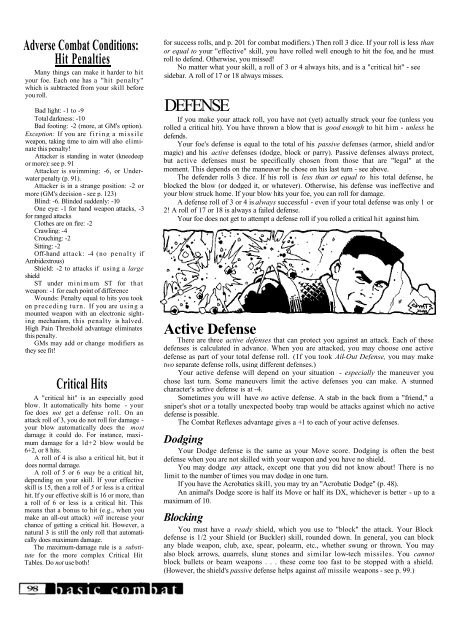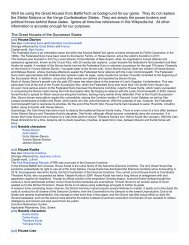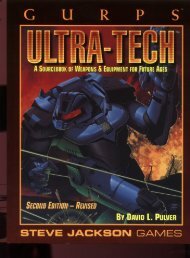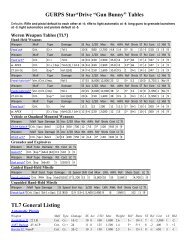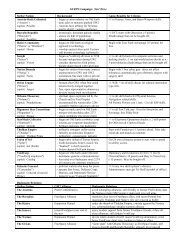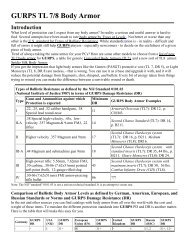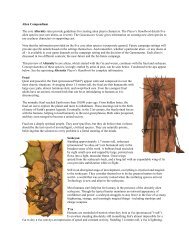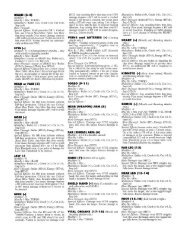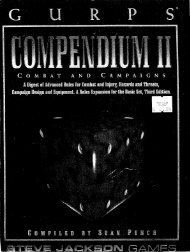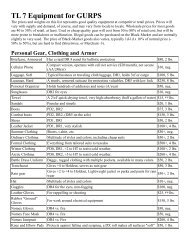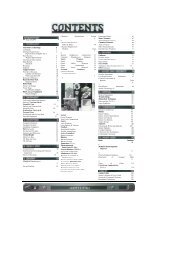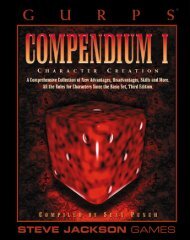WaitDo nothing unless a foe comes within your striking range before your next turn. Ifthat happens, you may attack (a regular attack, not all-out). Because movement isentirely abstract in the <strong>Basic</strong> System, you will rarely need this maneuver. You may useany defense on a turn you Wait.Ail-Out DefenseDefend yourself: do nothing else this turn. If you fail your defense roll against anyattack, you may try another (different) defense - in other words, you get two defenserolls, using two different active defenses against the same attack. You are limited to twoblocks and two parries per turn when you choose All-Out Defense, and you can't parrytwice with a weapon that becomes unready after a parry.ConcentrateCast a spell, or do anything else requiring mental concentration. If the character ishurt, knocked down, forced to use an active defense, or otherwise distracted, he mustmake a Will-3 roll to maintain his concentration.Long ActionThis is not a specific maneuver: it is a "generic" choice that allows you to do onesecond's worth of any multi-second action. The GM decides how many turns each "longaction" will take: see p. 107 for a table of some common actions. As a rule, no defenseexcept dodging is possible during a long action, but the GM can vary this as he sees fit.Any sort of defense may also interfere with whatever you are try ing to do.Free ActionsThese are things you can do during any maneuver. These include talking, droppingweapons or other objects, maintaining magical spells (if you are using magic), etc. See p.107 for more detail.MAKING AN ATTACKEach attack is resolved by three die rolls. First is your attack roll. If your roll issuccessful, your attack was a good one. Now your foe must make a defense roll to see if hecan defend against your blow. If he makes this roll, he is not hit. If he misses his defenseroll, your blow struck home and you roll for damage.If you choose the Attack, All-Out Attack or Wait maneuvers, you may try to hit afoe. In the <strong>Basic</strong> Combat System, you don't need to worry about the enemy's preciselocation. You may attack any foe. unless the GM rules that attack is impossible for somereason.You cannot attack unless your weapon is ready. A sword or knife is ready everyturn. An unbalanced weapon, like an axe. becomes unready when you swing it. so it canonly be used every other turn. See p. 104.Rolling to AttackYour "attack roll" is a regular success roll. Figure your effective skill (your basicskill plus or minus any appropriate modifiers) with the weapon you are using. (See p. 86Example of CombatLouis LeBlanc is the attacker. Hisweapon is a machete, which is considereda shortsword. His Shortsword skill is 15,and there are no adverse conditions to subtractfrom his roll. Therefore, he needs a15 or less to hit his foe. He swings androlls a 13, so he hits.His opponent. Filthy Pierre, has a Moveof 4 (giving him a Dodge of 4). He has aShield skill of 14 (giving him a shieldblockdefense of 7) and a Shortsword skillof 13 (giving him a parrying defense of 6).His Block is his best defense, so he willuse it whenever he can.Pierre's small shield is also good for apassive defense of 2 (see Types of Shields,p. 76).Pierre is wearing cloth armor, whichgives a passive defense of 1 (see Suits ofArmor, p. 72).So Pierre's defenses are 7 + 2 + 1, or a totalof 10. If he Blocks and rolls a 10 or less, hecan defend against the accurate blow thatLouis just threw. But 10 misses half the timeon 3 dice. He rolls - and gets an 11. Too bad!He's hit.Alt hough the combat calculations mayseem complex at first, they are simple inplay! The attacker rolls against his skill, asshown on his record sheet. The defenderadds up his defenses, as shown on hisrecord sheet, and rolls against the total.That's it!To continue the example: Louis isattacking Pierre. His blow was good, andPierre failed to defend. So the blow gotthrough.Now Louis rolls for damage. Louis'player has already figured how much damage hedoes with a shortsword, and written it on hisrecord sheet . ... his strength is 11, so hisswing does "ld+1" damage. He rolls one dieand gets a 4. Adding one point yields a 5.So Pierre is hit for 5 points of basic damage.However, Pierre is wearing cloth armor(Damage Resistance of 1.) This gives him 1point of protection. So only 4 points ofdamage get through the armor.But a sword is a cutting weapon! Thedamage that got through the armor isincreased by 50%, to 6! So Pierre takes 6 hitsof damage. That blow could knock a lesserman down. Sad but true .... one goodsword blow can settle a fight.Pierre's player subtracts 6 points fromPierre's HT. Luckily, this is not more than halfof Pierre's original HT of 12. So Pierre isnot stunned, and does not have to roll to see ifhe is knocked down. However, if he attackson his next turn, he must subtract 6 from hisskill! And the fight continues.
Adverse Combat Conditions:Hit PenaltiesMany things can make it harder to hityour foe. Each one has a "hit penalty"which is subtracted from your skill beforeyou roll.Bad light: -1 to -9Total darkness: -10Bad footing: -2 (more, at GM's option).Exception: If you are firing a missileweapon, taking time to aim will also eliminatethis penalty!Attacker is standing in water (kneedeepor more): see p. 91Attacker is swimming: -6, or Underwaterpenalty (p. 91).Attacker is in a strange position: -2 ormore (GM's decision - see p. 123)Blind: -6. Blinded suddenly: -10One eye: -1 for hand weapon attacks, -3for ranged attacksClothes are on fire: -2Crawling: -4Crouching: -2Sitting: -2Off-hand attack: -4 (no penalty ifAmbidextrous)Shield: -2 to attacks if using a largeshieldST under minimum ST for thatweapon: -1 for each point of differenceWounds: Penalty equal to hits you tookon preceding turn. If you are using amounted weapon with an electronic sightingmechanism, this penalty is halved.High Pain Threshold advantage eliminatesthis penalty.GMs may add or change modifiers asthey see fit!Critical HitsA "critical hit" is an especially goodblow. It automatically hits home - yourfoe does not get a defense roll. On anattack roll of 3, you do not roll for damage -your blow automatically does the mostdamage it could do. For instance, maximumdamage for a ld+2 blow would be6+2, or 8 hits.A roll of 4 is also a critical hit, but itdoes normal damage.A roll of 5 or 6 may be a critical hit,depending on your skill. If your effectiveskill is 15, then a roll of 5 or less is a criticalhit. If y our effective skill is 16 or more, thana roll of 6 or less is a critical hit. Thismeans that a bonus to hit (e.g., when youmake an all-out attack) will increase yourchance of getting a critical hit. However, anatural 3 is still the only roll that automaticallydoes maximum damage.The maximum-damage rule is a substitutefor the more complex Critical HitTables. Do not use both!for success rolls, and p. 201 for combat modifiers.) Then roll 3 dice. If your roll is less thanor equal to your "effective" skill, you have rolled well enough to hit the foe, and he mustroll to defend. Otherwise, you missed!No matter what your skill, a roll of 3 or 4 always hits, and is a "critical hit" - seesidebar. A roll of 17 or 18 always misses.DEFENSEIf you make your attack roll, you have not (yet) actually struck your foe (unless yourolled a critical hit). You have thrown a blow that is good enough to hit him - unless hedefends.Your foe's defense is equal to the total of his passive defenses (armor, shield and/ormagic) and his active defenses (dodge, block or parry). Passive defenses always protect,but active defenses must be specifically chosen from those that are "legal" at themoment. This depends on the maneuver he chose on his last turn - see above.The defender rolls 3 dice. If his roll is less than or equal to his total defense, heblocked the blow (or dodged it, or whatever). Otherwise, his defense was ineffective andyour blow struck home. If your blow hits your foe, you can roll for damage.A defense roll of 3 or 4 is always successful - even if your total defense was only 1 or2! A roll of 17 or 18 is always a failed defense.Your foe does not get to attempt a defense roll if you rolled a critical hit against him.Active DefenseThere are three active defenses that can protect you against an attack. Each of thesedefenses is calculated in advance. When you are attacked, you may choose one activedefense as part of your total defense roll. (If you took Ail-Out Defense, you may maketwo separate defense rolls, using different defenses.)Your active defense will depend on your situation - especially the maneuver youchose last turn. Some maneuvers limit the active defenses you can make. A stunnedcharacter's active defense is at -4.Sometimes you will have no active defense. A stab in the back from a "friend," asniper's shot or a totally unexpected booby trap would be attacks against which no activedefense is possible.The Combat Reflexes advantage gives a +1 to each of your active defenses.DodgingYour Dodge defense is the same as your Move score. Dodging is often the bestdefense when you are not skilled with your weapon and you have no shield.You may dodge any attack, except one that you did not know about! There is nolimit to the number of times you may dodge in one turn.If you have the Acrobatics skill, you may try an "Acrobatic Dodge" (p. 48).An animal's Dodge score is half its Move or half its DX, whichever is better - up to amaximum of 10.BlockingYou must have a ready shield, which you use to "block" the attack. Your Blockdefense is 1/2 your Shield (or Buckler) skill, rounded down. In general, you can blockany blade weapon, club, axe, spear, polearm, etc., whether swung or thrown. You mayalso block arrows, quarrels, slung stones and similar low-tech missiles. You cannotblock bullets or beam weapons . . . these come too fast to be stopped with a shield.(However, the shield's passive defense helps against all missile weapons - see p. 99.)
- Page 3 and 4:
17. FLIGHT.........................
- Page 5 and 6:
Materials Needed for PlayThe GURPS
- Page 7 and 8:
WHAT IS ROLEPLAYING?A roleplaying g
- Page 9 and 10:
Character TypesThere are no "charac
- Page 12 and 13:
Four numbers called "attributes" ar
- Page 14 and 15:
You are free to set the physical ap
- Page 16 and 17:
REPUTATIONSome characters are so we
- Page 18 and 19:
These are character traits that are
- Page 20 and 21:
Legal Enforcement Powers 5, 10 or 1
- Page 22 and 23:
Rapid Healing5 pointsThis advantage
- Page 24 and 25:
A minor deity as Patron to a travel
- Page 26 and 27:
ReputationVariable (see p. 17)Socia
- Page 28 and 29:
Lame-15,-25, or -35 pointsYou have
- Page 30 and 31:
Bad Temper-10 pointsYou are not in
- Page 32 and 33:
Dyslexia-5 or -15 pointsYou have a
- Page 34 and 35:
Pacifism-15 or -30 pointsYou are op
- Page 36 and 37:
Shyness-5,-10,-15 pointsYou are unc
- Page 38 and 39:
You have a significant responsibili
- Page 40 and 41:
A "quirk" is a minor personality tr
- Page 42 and 43:
SpecializingRequired Specialization
- Page 44 and 45:
MEANING OF SKILL LEVELSSo you have
- Page 46 and 47: Teamster (Mental/Average)Defaults t
- Page 48 and 49: Skiing (Physical/Hard)Defaults to D
- Page 50 and 51: Guns/TL (Physical/Easy)Defaults to
- Page 52 and 53: Any of these skills can be self-tau
- Page 54 and 55: Levels of Language SkillThis table
- Page 56 and 57: Most outdoor skills can be learned
- Page 58 and 59: PSIONIC SKILLSThese are special men
- Page 60 and 61: Forensics/TL (Mental/Hard)Defaults
- Page 62 and 63: Few Hundred Acres: Knowledge of far
- Page 64 and 65: Many skills in this category are ta
- Page 66 and 67: Lockpicking/TL (Mental/Average) Def
- Page 68 and 69: Gunner/TL See Combat Skills, p. 50M
- Page 70 and 71: Now you need to decide what equipme
- Page 72 and 73: Each suit of "real" armor includes
- Page 74 and 75: Listing Weapons On Your Character S
- Page 76 and 77: Recording Encumbrance on YourCharac
- Page 78 and 79: Passive Defense. The first blank is
- Page 80 and 81: The longer (and the more skillfully
- Page 82 and 83: When you improve a skill, the cost
- Page 84 and 85: Not all the advantages and disadvan
- Page 86 and 87: But remember . . . some skills have
- Page 88 and 89: ClimbingTo climb anything more diff
- Page 90 and 91: SwimmingThe Swimming skill (p. 49)
- Page 92 and 93: WILL ROLLSWhen a character is faced
- Page 94 and 95: The GURPS combat system is designed
- Page 98 and 99: You may only block one attack per t
- Page 100 and 101: Missile WeaponsMissile weapons are
- Page 102 and 103: At the end of your move, if you hav
- Page 104 and 105: The rules for attacking a foe are e
- Page 106 and 107: tell you how long it will take. In
- Page 108 and 109: You may normally parry only one att
- Page 110 and 111: CLOSE COMBATUsing the Move, Step an
- Page 112 and 113: (adjusted) ST! Note that a shield h
- Page 114 and 115: Ranged Weapon StatsFor each ranged
- Page 116 and 117: second. On the table, this rounds u
- Page 118 and 119: If you are using the "hit location"
- Page 120 and 121: Removing or folding the stock of a
- Page 122 and 123: After the initial "freeze" ends, ea
- Page 124 and 125: ATTACKING INANIMATE OBJECTSThere ar
- Page 126 and 127: This subtraction will mostoften aff
- Page 128 and 129: Psionic healing (p. 175) and magica
- Page 130 and 131: DrowningSee the rules for Swimming,
- Page 132 and 133: protects completely. Toughness prot
- Page 134 and 135: Resolving mounted or vehicular comb
- Page 136 and 137: Using Ranged Weapons From Horseback
- Page 138 and 139: This section covers special rules f
- Page 140 and 141: HT: Health and Hit PointsFor a roug
- Page 142 and 143: Swarm AttacksA group of small creat
- Page 144 and 145: Encumbrance and MovementEncumbrance
- Page 146 and 147:
A critical miss means the energy co
- Page 148 and 149:
oll will not end the spell, but the
- Page 150 and 151:
If the subject makes the resistance
- Page 152 and 153:
won't work. If anyone but the caste
- Page 154 and 155:
ANIMAL SPELLSThese are the spells r
- Page 156 and 157:
If the summoning spell is repeated,
- Page 158 and 159:
Cost: 1 for an object up to the siz
- Page 160 and 161:
Armor EnchantmentsThese spells work
- Page 162 and 163:
AuraInformationShows the caster a g
- Page 164 and 165:
Psionics, or "psi" abilities, are p
- Page 167 and 168:
GlossaryESP - Extra-Sensory Percept
- Page 169 and 170:
Psionics and MagicMagic and psionic
- Page 171 and 172:
PSYCHOKINESISThis power covers movi
- Page 173 and 174:
Pside EffectsPsi skills can have "s
- Page 175 and 176:
Limitations(Continued)Fickle: varia
- Page 177 and 178:
Player-Made MapsWhenever the player
- Page 179 and 180:
Predetermined ReactionsCertain NPCs
- Page 181 and 182:
Dealing with the PlayersArgumentsAs
- Page 183 and 184:
Time Use SheetsThe Time Use Sheet (
- Page 185 and 186:
Weapons and Armor0. Fists and stone
- Page 187 and 188:
Weather(Continued)WindWinds from ga
- Page 189 and 190:
Gold and SilverA traditional assump
- Page 191 and 192:
JobsThe jobs available in each game
- Page 193 and 194:
Job (Prerequisites), Monthly Income
- Page 195 and 196:
Sooner or later, every GM wants to
- Page 197 and 198:
Features of a GoodAdventureA good a
- Page 199 and 200:
World-BuildingA game world is a com
- Page 201 and 202:
CRITICAL HIT TABLEAll doublings or
- Page 203 and 204:
When the players meet an NPC whose
- Page 205 and 206:
Weapons are listed in groups, accor
- Page 207 and 208:
MODERN AND ULTRA-TECH WEAPONSWeapon
- Page 209 and 210:
ANCIENT/MEDIEVAL ARMORUse this tabl
- Page 211 and 212:
FANTASY/MEDIEVAL EQUIPMENTThe follo
- Page 231 and 232:
After eight printings of the GURPS
- Page 233 and 234:
of Divination should match the "fla
- Page 235 and 236:
Minor disadvantage: -5 points. Agai
- Page 237 and 238:
Whether through an accident of birt
- Page 239 and 240:
Note that this disadvantage is inco
- Page 241 and 242:
SKILLSARTISTIC SKILLSVideo Producti
- Page 243 and 244:
traders, and chess-like games are c
- Page 245 and 246:
If, during an adventure, a philosop
- Page 247 and 248:
VITAL ORGANSThese are optional rule
- Page 256 and 257:
INSTANT CHARACTERSThis quick refere


